Mdina, the ``Silent City`` of Malta, holds centuries of history within its fortified walls. A walking tour through Mdina is a journey through time, a chance to unravel the rich tapestry of Malta's past. This guide will serve as your companion, offering insights into the historical significance, top attractions, hidden gems, and practical tips for an unforgettable Mdina walking tour.
Uncovering Mdina's Rich History: A Walking Tour Journey
Mdina stands as a living testament to Malta's storied past. As you embark on a walking tour through its narrow streets, you step into a world shaped by Phoenician, Roman, Arab, and Norman influences. The city served as the island's capital until the arrival of the Knights of St. John in 1530.
Origins and Evolution
Mdina's origins date back over 4,000 years, making it one of Europe's oldest continuously inhabited cities. Originally known as Maleth by the Phoenicians, the city underwent numerous transformations over the centuries. Each conqueror left its mark, contributing to the unique blend of architectural styles and cultural heritage we witness today.
The Norman Influence
The Normans, led by Count Roger I, played a pivotal role in Mdina's history. Under their rule, the city flourished, earning the nickname ``Medina`` or ``walled city.`` The impressive Norman architecture, characterized by sturdy fortifications and stone structures, remains a highlight of walking tours.
Knights of St. John Era
In 1530, the Knights of St. John established their base in Malta, and Mdina lost its status as the capital to the newly built Valletta. However, the city continued to play a crucial role in Malta's history. Walking tours provide an opportunity to delve into this fascinating history, uncovering tales of knights, battles, and the enduring spirit of Mdina.

The St Paul's Cathedral
St. Paul's Cathedral in Mdina, Malta, is a historic church with roots dating back to the 12th century. Rebuilt in the Baroque and Sicilian styles after the earthquake of 1693, the cathedral features an ornate facade adorned with stone carvings. Inside, visitors encounter a lavish interior with frescoes, sculptures, and paintings. Dedicated to Saint Paul, the cathedral serves as a religious center in Mdina and attracts both pilgrims and tourists. The peaceful ambiance of Mdina complements the cathedral's historical and cultural significance.

The St Paul's Cathedral
St. Paul's Cathedral in Mdina, Malta, is a historic church with roots dating back to the 12th century. Rebuilt in the Baroque and Sicilian styles after the earthquake of 1693, the cathedral features an ornate facade adorned with stone carvings. Inside, visitors encounter a lavish interior with frescoes, sculptures, and paintings. Dedicated to Saint Paul, the cathedral serves as a religious center in Mdina and attracts both pilgrims and tourists. The peaceful ambiance of Mdina complements the cathedral's historical and cultural significance.
Casa Gourgion
A distinctive architectural anomaly catches the eye amidst its neighboring structures. Crafted by Andrea Vassallo, this residential dwelling stands as a relatively uncommon specimen of neo-Gothic architecture in Malta. Traditionally inclined towards Baroque designs, the country diverges from its usual architectural preferences with this unique neo-Gothic residence. While now embraced by both the public and tourists, the unconventional style faced initial criticism upon its debut in the early 20th century. The building's elaborate facade, detailed rooftop, and prominent arches unmistakably reveal its roots in the distinct Gothic Revival architectural tradition.
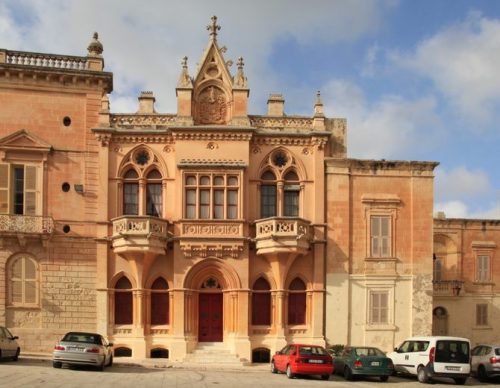

Casa Gourgion
A distinctive architectural anomaly catches the eye amidst its neighboring structures. Crafted by Andrea Vassallo, this residential dwelling stands as a relatively uncommon specimen of neo-Gothic architecture in Malta. Traditionally inclined towards Baroque designs, the country diverges from its usual architectural preferences with this unique neo-Gothic residence. While now embraced by both the public and tourists, the unconventional style faced initial criticism upon its debut in the early 20th century. The building's elaborate facade, detailed rooftop, and prominent arches unmistakably reveal its roots in the distinct Gothic Revival architectural tradition.

Palazzo Santa Sofia
Palazzo Santa Sofia, situated on Villegaignon Street in Mdina, Malta, is a historic palace facing the cathedral square. Its foundation dates back to 1233, making it reputedly the oldest surviving structure in the city. However, the upper floor, a product of 20th-century construction, represents a more recent addition.

Palazzo Santa Sofia
Palazzo Santa Sofia, situated on Villegaignon Street in Mdina, Malta, is a historic palace facing the cathedral square. Its foundation dates back to 1233, making it reputedly the oldest surviving structure in the city. However, the upper floor, a product of 20th-century construction, represents a more recent addition.
Carmelite Church
The Carmelite Church in Mdina, Malta, is a historically significant religious site. Located in the heart of the city, it reflects a blend of medieval and Baroque architecture. The church, associated with the Carmelite Order, holds religious importance and features ornate interiors with religious art. A visit to this site offers insight into Mdina's rich history and cultural heritage.
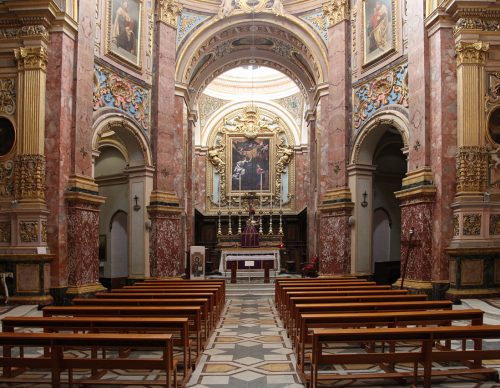

Carmelite Church
The Carmelite Church in Mdina, Malta, is a historically significant religious site. Located in the heart of the city, it reflects a blend of medieval and Baroque architecture. The church, associated with the Carmelite Order, holds religious importance and features ornate interiors with religious art. A visit to this site offers insight into Mdina's rich history and cultural heritage.

Falson Palace
Falson Palace in Mdina, Malta, showcases a unique blend of medieval and Renaissance architecture. Originally a residence for noble families, it now houses the Palazzo Falson Historic House Museum, featuring art, antiques, and historical artifacts. This cultural attraction offers a glimpse into Mdina's rich history and architectural heritage.

Falson Palace
Falson Palace in Mdina, Malta, showcases a unique blend of medieval and Renaissance architecture. Originally a residence for noble families, it now houses the Palazzo Falson Historic House Museum, featuring art, antiques, and historical artifacts. This cultural attraction offers a glimpse into Mdina's rich history and architectural heritage.
Bastion Square
Amidst the enchanting alleys of Mdina lies Bastion Square, a treasure trove of history where various civilizations have left their mark. The square's unique atmosphere, bustling with tourists and locals, invites you to savor the present moment. From charming cafes, you can admire the surrounding city of Rabat and the majestic Mosta dome in the distance. Bastion Square serves as a bridge between Mdina's rich past and modern life, leaving visitors captivated by its timeless allure.


Bastion Square
Amidst the enchanting alleys of Mdina lies Bastion Square, a treasure trove of history where various civilizations have left their mark. The square's unique atmosphere, bustling with tourists and locals, invites you to savor the present moment. From charming cafes, you can admire the surrounding city of Rabat and the majestic Mosta dome in the distance. Bastion Square serves as a bridge between Mdina's rich past and modern life, leaving visitors captivated by its timeless allure.

The Knights of Malta
The Knights of Malta is a unique series of expertly captured scenes from the original tales of the life and times of the Crusader Knights. Discover how in 1530, Grand Master L’Isle Adam entered the Gates of the fortified city of Mdina. Bringing the past to life with a creative achievement produced by special effects, dramatic lighting that depicts the energy of those who lived, fought and died in bygone centuries. Truly an extraordinary experience, exciting for all ages.

The Knights of Malta
The Knights of Malta is a unique series of expertly captured scenes from the original tales of the life and times of the Crusader Knights. Discover how in 1530, Grand Master L’Isle Adam entered the Gates of the fortified city of Mdina. Bringing the past to life with a creative achievement produced by special effects, dramatic lighting that depicts the energy of those who lived, fought and died in bygone centuries. Truly an extraordinary experience, exciting for all ages.
The Greeks Gate
The Greeks Gate, one of the three entrances to Mdina, is a petite gateway situated at the base of the city's ditch. Above the gate's interior side, a painting depicts St. Nicholas breaking bread, reflecting an ancient Maltese tradition of hospitality where guests are welcomed with shared bread. The gate's foundation stones date back to the Roman era, while the gate structure itself was erected during medieval times. In 1724, as part of the city's reconstruction, Architect De Mondion added a baroque touch to the gate's exterior. Historically, this gate provided access to the Greek and Jewish quarters of the city.
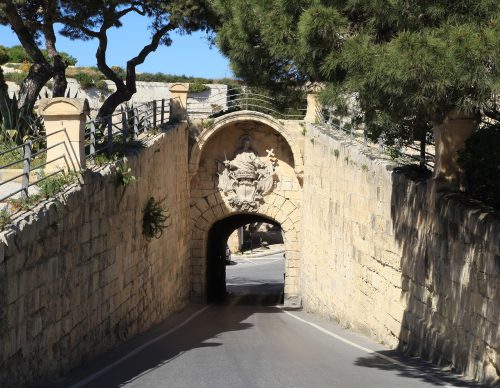

The Greeks Gate
The Greeks Gate, one of the three entrances to Mdina, is a petite gateway situated at the base of the city's ditch. Above the gate's interior side, a painting depicts St. Nicholas breaking bread, reflecting an ancient Maltese tradition of hospitality where guests are welcomed with shared bread. The gate's foundation stones date back to the Roman era, while the gate structure itself was erected during medieval times. In 1724, as part of the city's reconstruction, Architect De Mondion added a baroque touch to the gate's exterior. Historically, this gate provided access to the Greek and Jewish quarters of the city.
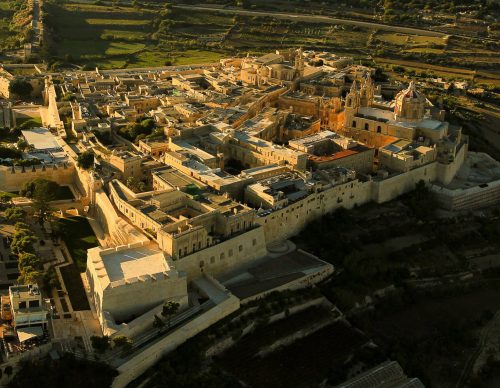
The Fortifications of Mdina
The fortifications of Mdina, Malta, form a formidable defensive network that encapsulates the historic city. Noted for their strategic significance, these fortifications date back to various periods, including medieval, Norman, and later modifications during the rule of the Order of St. John. The defensive walls and bastions not only safeguarded the city but also showcased architectural prowess. Visitors can explore the well-preserved ramparts, gates, and watchtowers, gaining insights into Mdina's military history and its role as a medieval stronghold. The fortifications contribute to Mdina's charm, offering a glimpse into Malta's rich and resilient past.

The Fortifications of Mdina
The fortifications of Mdina, Malta, form a formidable defensive network that encapsulates the historic city. Noted for their strategic significance, these fortifications date back to various periods, including medieval, Norman, and later modifications during the rule of the Order of St. John. The defensive walls and bastions not only safeguarded the city but also showcased architectural prowess. Visitors can explore the well-preserved ramparts, gates, and watchtowers, gaining insights into Mdina's military history and its role as a medieval stronghold. The fortifications contribute to Mdina's charm, offering a glimpse into Malta's rich and resilient past.
Mesquita Square
Mesquita Square, a central hub in Mdina, is a captivating thoroughfare for locals and tourists. The square's ancient well stands as a testament to its rich history, symbolizing the city's enduring heritage. Surrounded by historic stone buildings from the Middle Ages, the square's architecture transports visitors back in time. Notably, Mesquita Square has gained recognition as a backdrop in the popular series ``Game of Thrones.`` With its blend of history and entertainment, the square becomes a treasure trove for enthusiasts of ancient architecture, offering a captivating glimpse into the city's past and bridging the gap between eras.
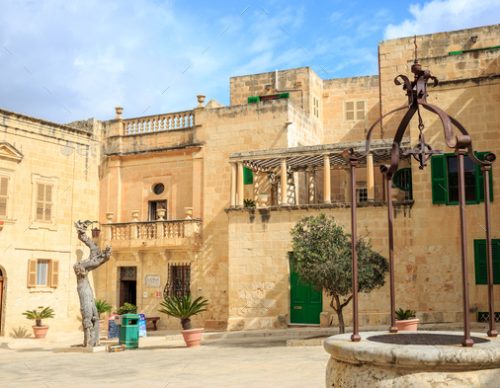

Mesquita Square
Mesquita Square, a central hub in Mdina, is a captivating thoroughfare for locals and tourists. The square's ancient well stands as a testament to its rich history, symbolizing the city's enduring heritage. Surrounded by historic stone buildings from the Middle Ages, the square's architecture transports visitors back in time. Notably, Mesquita Square has gained recognition as a backdrop in the popular series ``Game of Thrones.`` With its blend of history and entertainment, the square becomes a treasure trove for enthusiasts of ancient architecture, offering a captivating glimpse into the city's past and bridging the gap between eras.
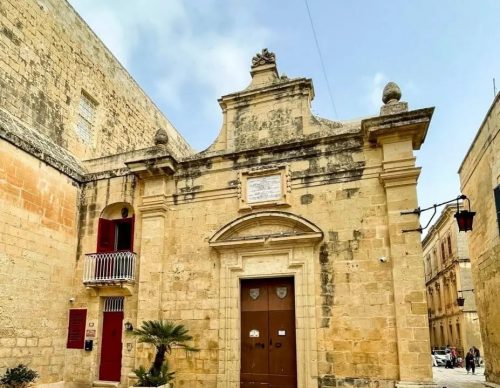
Saint Agatha's Chapel
Saint Agatha's Chapel in Mdina, Malta, is a historic site dedicated to the Christian martyr Saint Agatha. With medieval architecture, the chapel holds religious significance, attracting visitors seeking a connection to Malta's cultural and religious heritage. It stands as a serene space for contemplation in the heart of Mdina's historic surroundings.

Saint Agatha's Chapel
Saint Agatha's Chapel in Mdina, Malta, is a historic site dedicated to the Christian martyr Saint Agatha. With medieval architecture, the chapel holds religious significance, attracting visitors seeking a connection to Malta's cultural and religious heritage. It stands as a serene space for contemplation in the heart of Mdina's historic surroundings.
The National Museum of Natural History
Housed in a stellar location in an 18th-century palace within the fortified city of Mdina, the National Museum of Natural History has a long history to tell. The palace was constructed in the Parisian Baroque style by Grand Master Antonio Manoel de Vilhena in 1724 and served as a temporary hospital during the 1837 cholera outbreak as a sanitorium for British troops in 1860 and a hospital of tuberculosis patients till January 1956. On 22nd June 1973 the National Museum of Natural History was officially inaugurated and opened for public viewing. It and was entrusted with the acquisition, collection, display and conservation of natural history specimens, with special emphasis on local Flora and Fauna. The display areas cover various topics, including local biodiversity and ecology, geology and paleontology, mineralogy, human evolution, marine fauna, skeletal structures, insects, shells, and birds.
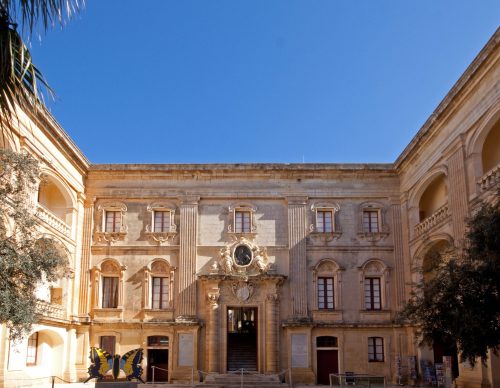

The National Museum of Natural History
Housed in a stellar location in an 18th-century palace within the fortified city of Mdina, the National Museum of Natural History has a long history to tell. The palace was constructed in the Parisian Baroque style by Grand Master Antonio Manoel de Vilhena in 1724 and served as a temporary hospital during the 1837 cholera outbreak as a sanitorium for British troops in 1860 and a hospital of tuberculosis patients till January 1956. On 22nd June 1973 the National Museum of Natural History was officially inaugurated and opened for public viewing. It and was entrusted with the acquisition, collection, display and conservation of natural history specimens, with special emphasis on local Flora and Fauna. The display areas cover various topics, including local biodiversity and ecology, geology and paleontology, mineralogy, human evolution, marine fauna, skeletal structures, insects, shells, and birds.

Mdina Dungeons Museum
Located beneath the Magisterial Vilhena Palace near Mdina's main entrance gate, the Mdina Dungeons offer a captivating journey through Maltese history's darker chapters. In these underground passages, events from Roman times to the era of the Knights and Napoleon are vividly recreated, unveiling dramatic and sometimes unbelievable stories. As visitors explore at their own pace, they encounter drama, mystery, and horror, immersing themselves in an authentic medieval dungeon atmosphere. The museum covers various periods in Malta's history, including Romans, Byzantines, Arabs, Knights, and French, shedding light on times marked by crucifixion, beheading, public executions, torture, crime, revolts, conspiracies, imprisonment, and inquisitions. The Mdina Dungeons Museum provides a bold and memorable experience, delving into the forgotten and haunting aspects of Malta's dark past.

Mdina Dungeons Museum
Located beneath the Magisterial Vilhena Palace near Mdina's main entrance gate, the Mdina Dungeons offer a captivating journey through Maltese history's darker chapters. In these underground passages, events from Roman times to the era of the Knights and Napoleon are vividly recreated, unveiling dramatic and sometimes unbelievable stories. As visitors explore at their own pace, they encounter drama, mystery, and horror, immersing themselves in an authentic medieval dungeon atmosphere. The museum covers various periods in Malta's history, including Romans, Byzantines, Arabs, Knights, and French, shedding light on times marked by crucifixion, beheading, public executions, torture, crime, revolts, conspiracies, imprisonment, and inquisitions. The Mdina Dungeons Museum provides a bold and memorable experience, delving into the forgotten and haunting aspects of Malta's dark past.
The Mdina Gate
The Mdina Gate, located in the historic city of Mdina, Malta, serves as a prominent entrance to this ancient walled city. Rich in history and architectural significance, the gate welcomes visitors with its grand structure and impressive design. Over the centuries, it has stood witness to various historical events and remains a symbol of Malta's cultural heritage. As one passes through the Mdina Gate, they embark on a journey into the past, exploring the narrow medieval streets and experiencing the charm of this well-preserved fortress city.
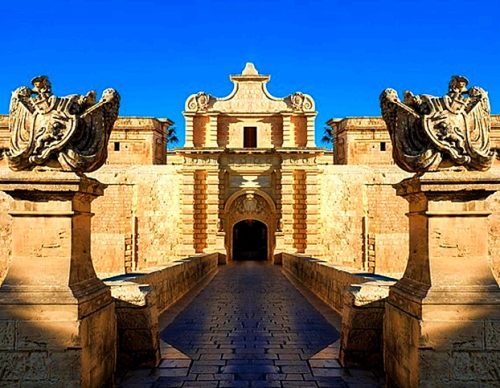

The Mdina Gate
The Mdina Gate, located in the historic city of Mdina, Malta, serves as a prominent entrance to this ancient walled city. Rich in history and architectural significance, the gate welcomes visitors with its grand structure and impressive design. Over the centuries, it has stood witness to various historical events and remains a symbol of Malta's cultural heritage. As one passes through the Mdina Gate, they embark on a journey into the past, exploring the narrow medieval streets and experiencing the charm of this well-preserved fortress city.

The Howard Gardens
Howard Gardens, named after Malta's first Prime Minister Joseph Howard, OBE (1862-1925), and inaugurated in 1942, is among the larger gardens in Malta. Situated between Rabat and Mdina, it serves as a natural border between the two cities, featuring an orchard of orange trees, a football ground, a tennis court, trees, shrubs, benches, and pathways. Popular for sightseeing, Howard Gardens provides pleasant views of Mdina's bastions, offering a tranquil spot to unwind after exploring Mdina and Rabat.

The Howard Gardens
Howard Gardens, named after Malta's first Prime Minister Joseph Howard, OBE (1862-1925), and inaugurated in 1942, is among the larger gardens in Malta. Situated between Rabat and Mdina, it serves as a natural border between the two cities, featuring an orchard of orange trees, a football ground, a tennis court, trees, shrubs, benches, and pathways. Popular for sightseeing, Howard Gardens provides pleasant views of Mdina's bastions, offering a tranquil spot to unwind after exploring Mdina and Rabat.
Culinary Experiences in Mdina
A walking tour through Mdina is not just a feast for the eyes but also an opportunity to indulge your taste buds in the rich flavors of Maltese cuisine. Here's a guide to the culinary delights that await you as you explore the gastronomic treasures within the Silent City.
• Best Time to Explore Mdina: Mdina's charm varies with the time of day. Consider starting your walking tour in the early morning or late afternoon when the soft sunlight enhances the city's golden hues. Evening tours, with the city lights aglow, offer a magical atmosphere, especially during sunset.
• Entry Requirements and Fees: Before setting out, check if there are any entry requirements for specific attractions within Mdina. Some locations may have entrance fees, and it's helpful to plan accordingly. Information about opening hours and ticket prices can usually be found on official websites.
Free Guided Mdina Walking Tours
Find free walking tour options that suits your preferences. Free tours do not have a set price, instead, the guides rely on the tips of participants to sustain their livelihoods. By contributing a fair amount that reflects the value you receive from the tour, you not only support the guides but also express your appreciation for their expertise and dedication.
In the heart of Malta lies a city frozen in time, where every cobblestone whispers tales of centuries past. Mdina, the Silent City, invites explorers on a captivating journey through its narrow streets and historic wonders. This ultimate guide has unveiled the richness of Mdina's history, highlighted its must-see attractions, and provided practical tips for an immersive walking tour.
As you traverse the enchanting streets of Mdina, St. Paul's Cathedral stands as a testament to the city's enduring legacy, while the Mdina Dungeons reveal the darker chapters of its history. Palazzo Falson opens a window into the grandeur of bygone eras, and Bastion Square offers panoramic views that capture the essence of Malta.
Venturing off the beaten path, hidden gems like Mesquita Square and St. Agatha's Catacombs provide a glimpse into Mdina's quieter, mysterious corners. Through the lens of your camera, you can immortalize the magic of Mdina, capturing the golden hours, intricate details, and the city's nightly transformation into a realm of lights.
In conclusion, Mdina is not merely a destination; it's a timeless journey. As you immerse yourself in its history, savor its flavors, and capture its beauty, you become a part of the living narrative of the Silent City. So, lace up your comfortable shoes, grab your camera, and set forth on a walking tour through Mdina, where every step is a passage through the corridors of history.




Comment (0)